By Brooks Paternotte
[dropcap]M[/dropcap]any of us were drawn to fly fishing through angling for trout and only found other species, places, etc. once we had cut our teeth on brooks in our home states. Needless to say, such quarry often proved skittish, diminutive, and rarely abundant. Don’t get me wrong – I absolutely love fishing for those trout. I rig up my wood, put on a dry fly, and try to trick little fish. That’s fun, but they don’t pull much unless we have bucked up fare to Patagonia, Jackson, or Anchorage. So where’s that leave us regular fly junkies looking for our next easy fix? Bass, my friend, bass.I know some guys who say they only will sink to smallies if there aren’t proper salmonids to catch, but they are full of it. Yes, the smallies are great when you can find them and they tend to pull pretty freaking hard, but the lowly big mouth is the king in my mind for several reasons. First, they are killers. They love to eat and attack their prey with a vengeance. Recently I hooked a nice bluegill. As I pulled it in, the bass started swarming the poor thing. By the time I released the weary brim, it was too tired to out swim its predators. Before I knew it, five largemouths were trying to see who could swallow the little guy whole. One did with a violent flourish. Watch them hunt sometime and you will see something similar. Second, they are ubiquitous. You can’t find a decent farm pond between New England and South Texas without them. You don’t even need to stock them – their eggs will often transport on the feet of waterfowl as they migrate the north American flyways every year and their favorite snack, bluegills, do the same (where you find one you will likely find the other). Third, they react to both sound and motion and will attack without hesitation; in other words, they will take a fly willingly. Plentiful, widely found, and willing – I suppose there are many things in life we wish we’re similarly characterized.
I have tried to refine my bass fishing program over the years to accommodate both a busy schedule (job, children, farm animals, and spouse) and a need for a strong pull from a commodious fish. Through trial and error, I have found the patterns, rigs, and times to find my local big mouths with confidence, but you need to put in some time to get to this point in any area fishing for any species. I will gladly share with you my provincial knowledge, but you will need to get after it on your own locally to find your best gig. I live in Baltimore County, Maryland, so what follows is relevant for that and the surrounding area.
Access to good, unpressured water is vital; yes, public water is abundant and accessible, but it is also pressured by baitslingers and the like. I suggest looking for privacy first. I have found through conversations with friends, relatives, and fellow sportsmen a few close, relatively private, and productive ponds. Once you have your spots, figure out the water and the food. I have found that ponds as close as a few hundred yards will have fish with very disparate appetites. For example, in one pond I fish, they love crawdads, while in another at the next farm over the big bass prefer baitfish imitations.
If you are like me and love to secretly watch the bass channel on Saturday mornings before the wife and kids wake, then pay attention. Those guys might as well be using flies – how much does the “banjo minnow” act like a CK minnow? The only difference is how you get the fly or lure in front of the fish.
Like our lure and bait slinging brothers, I bring a few rods to the pond to expedite the fishing. No need to switch sinking lines, leaders, flies, etc… Just bring rods rigged for top water, intermediate, and full sink. If you can’t catch them on top, in the middle, or on the bottom, sell your gear and quit. I usually try on top first with a green popper or some sort of frog imitation. Make noise with it as soon as it lands and see if anyone is hungry nearby. My top water box is also stocked with a variety of divers and other poppers in a wide variety of sizes and colors – from chartreuse to black. The fish seem to like flies with rubber legs or other such material giving the fly additional action on the surface.
The intermediate – I use a floating line, slow sink tip, and sinking fly here. Let it drop then give it action. Try different stripping patterns to see which one induces a strike. And hold on tight. Here I prefer baitfish imitations like large profile flies, sculpins, clousers, deceivers, and articulated patterns. I find that black, green, and natural colors work best on waters I work, but you will need to study your local pond to get the best sense of the color selection.
With full sink, I am using a pattern best fished along the bottom in clear water without obstacles. It is really fun when you can fish these guys like bonefish on a sandy bottom watching them slurp up their prey, turn, flash, and run. Like our friends on the pro tour, reactin’ time is key. They will spit a fly faster than you can imagine, so get the hang of setting the hook hard and quick.
Down on the bottom I’m using largely crawfish imitations, preferably patterns tied with the hook up. Some successful anglers suggest using patterns with small claws since the fish may naturally (and wisely) prey upon those crawfish with less intimidating weaponry. Personally, I have found the most success with Chuck Kraft’s crawdad pattern in tan, black/blue, and black/olive. Chuck’s flies, including such outstanding ties as the Creelex, the CK minnow, and his crawfish pattern are available through my buddy Doug Lane’s shop, Angler’s Lane, in Virginia.
Once you can convince them to eat, the fun is on. They will jump, run, and head shake like the best of them. I do find that you can’t let them get too much line on you as they will wrap around something and break you off before you know it. To prevent disappointing mishaps, I suggest using heavier tippet than you may be inclined to use. Bass do not seem to be overly leader shy, so I suggest using a leader tapered to six or eight pounds with a couple feet of Maxima tippet – I carry six, eight, and ten pound in all three colors to best match the water conditions and fish. Sometimes you will need heavy tippet to pull strong fish out of the weeds or they will smoke you. Additionally, you may connect with a big catfish or carp and you will be glad to have the confidence in your rig that ten pound line will provide (see photo). Recently, I was catching up with a farmer whose ponds I fish. He mentioned that another guy he allows to fish his water caught a 10#er on spinning gear – you just never know when Sir Lunkcelot will decide to tangle with you.
In general, I fish heavier and stiffer rods for bass, preferring five and six weights to turn over the heavy flies, yet still allow for the fun and excitement of fishing with super light gear. I suggest using a 8.5′ rod with a strong butt section; a faster action will not only help with turning over your leader and getting flies to the fish, but also will translate your strike-set into a hook-up. In order to achieve this, be sure to keep slack out of your line and have an eye out for the flash of a bass before you feel the tug. If you can react successfully to the flash, your hook up rate will increase dramatically and translate into more fish landed.
Well beyond the obvious fun of stalking and catching these aggressive predators are the memories you can foster and create with the next generation of anglers. As I mentioned before, bluegills share the water with bass and are willing quarry for a novice fly fisherman. As long as they can get the fly in their mouth, they will shamelessly take it. My son and I have enjoyed many afternoons of fishing together for bass and bluegills – he beating the water with an old three weight and a barbless nymph, me with my quiver of bass rigs. As he would say, “this is the best day for us mans ever.”



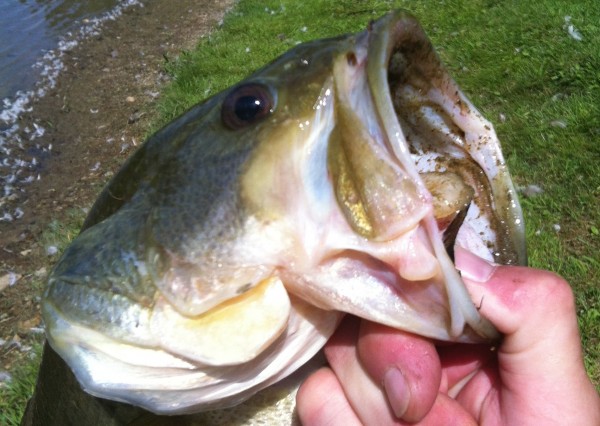
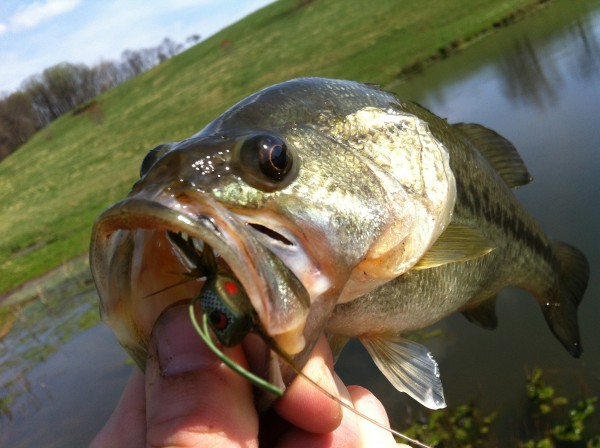
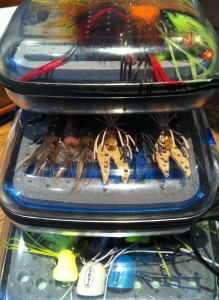
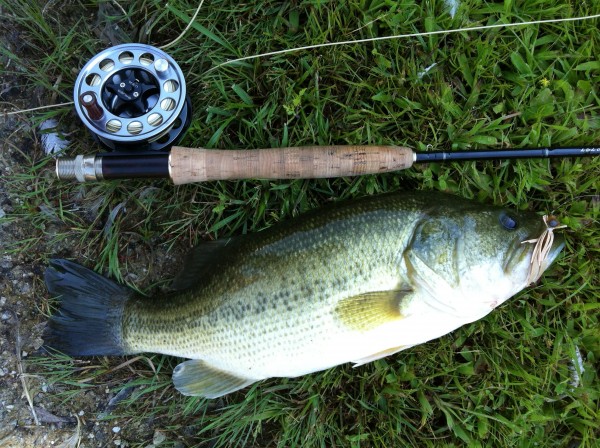
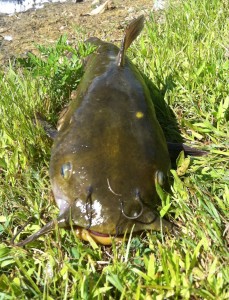
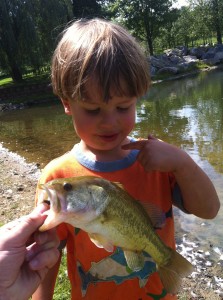
Best day for us WOMEN TOO!